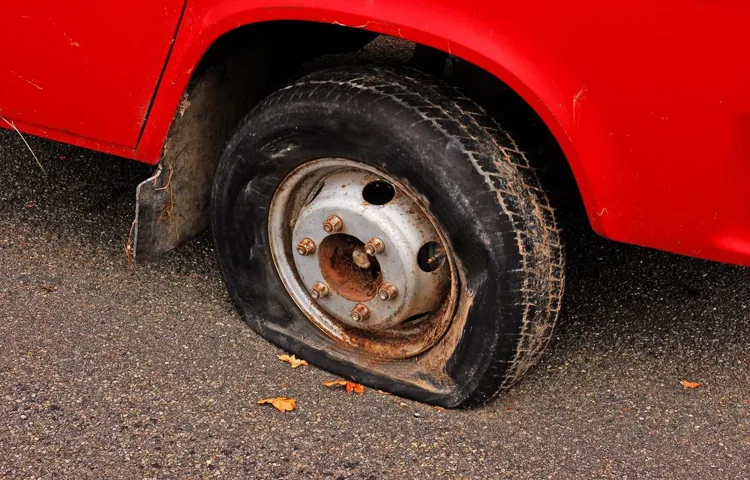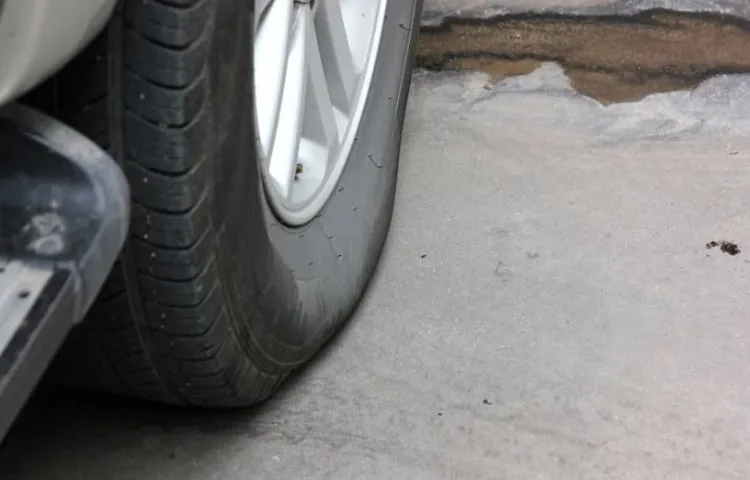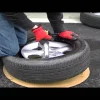Have you ever been driving down the road and felt like something was off with your car? Perhaps you noticed that the steering felt a bit strange, or maybe you heard an unusual noise coming from one of your tires. If you’re wondering how to tell if your tire is flat, you’re not alone. This is a common concern for drivers, and it’s important to know how to recognize the signs of a flat tire so that you can take action before things get worse.
In this blog post, we’ll discuss some ways to identify a flat tire and what to do if you encounter one on the road. So, buckle up and let’s get started!
Visual Inspection
One way to tell if your tire is flat is by visually inspecting it. Check to see if the tire is level and has proper inflation. A flat tire will appear significantly lower than normal and may have a bulge or dip in the sidewall.
Another indication of a flat tire is if it looks visibly deflated compared to other tires on the vehicle. Use your hands to feel the tire’s surface for any cuts, punctures, or debris such as rocks or nails. These could potentially cause flat tires.
Additionally, pay attention to any unusual sounds or vibrations while driving as this may also indicate a flat tire. If you suspect that your tire may be flat, it’s best to pull over and check it out.
Look for a flattened or bulging area on your tire.
When it comes to tire safety, doing a quick visual inspection can make a world of difference. One important thing to look out for is a flattened or bulging area on your tire. These deformities can signal a weak spot in the tire, which could lead to a blowout or sudden loss of control while driving.
So, the next time you’re checking your tire pressure or filling up on gas, take a minute to give your tires a once-over. Look for any unusual bulges, and use your fingers to feel for any soft spots or irregularities. If you do notice any issues, it’s best to have your tires checked by a professional mechanic to ensure they’re safe and road-worthy.
Remember, your tires are your vehicle’s only contact with the road, so it pays to take good care of them.

Check for any foreign objects, such as nails or screws, embedded in the tire.
When it comes to tire maintenance and safety, never underestimate the power of a visual inspection. One of the top things to check for during your inspection is foreign objects such as nails or screws embedded in the tire. These objects can cause slow leaks or even lead to a blowout, which can be extremely dangerous.
Even if the object appears to be small or harmless, it’s crucial to get it removed as soon as possible to avoid any further damage. To begin your inspection, start by examining the tire carefully, looking for anything that seems out of place. Be sure to check all sides of the tire, including the tread and sidewall.
If you do spot a foreign object, avoid removing it yourself, as this can cause more damage to the tire. Instead, take your car to a professional tire technician who can safely remove the object and assess any harm or repairs needed. Incorporating a visual inspection into your regular tire maintenance routine can save you from potential hazards and ensure the longevity of your tires.
Remember to always take safety precautions seriously and have any issues addressed promptly by a professional.
Inspect the valve stem to make sure it is not damaged or leaking air.
When it comes to taking care of your tires, one essential component that often gets overlooked is the valve stem. A quick and easy visual inspection can save you from potential problems down the road. Check the valve stem for any signs of damage, such as cracks, cuts, or tears.
If you notice any damage, it’s time to replace the valve stem as soon as possible. Another critical factor to consider during your inspection is whether the valve stem is leaking air. Over time, valves can wear out, causing tiny leaks that can lead to rapid air loss and tire failure.
Use a soapy water solution to check for air leaks, looking for bubbles forming around the valve stem. If you find any leaks, you may need to replace the valve core or repair the valve stem. By regularly inspecting your valve stems, you can help extend the life of your tires, improve safety on the road, and save money in the long run.
Physical Tests
If you suspect that your tire is flat, there are a few physical tests you can do to confirm your suspicions. The first and most obvious test is to check for any visible signs of deflation. Look for any noticeable bulges or bumps on the tire, as this could indicate a leak or puncture.
Additionally, if the tire appears noticeably lower than the others, this could also be a sign of a flat. You can also perform the bounce test, which involves pressing down on the center of the tire and observing how quickly it rebounds. A fully inflated tire will bounce back quickly, while a flat tire will feel mushy and barely bounce at all.
Finally, if you’re still unsure, you can use a tire pressure gauge to measure the air pressure in the suspected flat tire. If the reading is significantly lower than the manufacturer’s recommended pressure, it’s likely that your tire is in fact flat. By performing these simple physical tests, you can easily determine whether or not your tire is flat and take the appropriate actions.
Use a tire pressure gauge to check the air pressure in the tire.
One of the most important physical tests you can perform on your vehicle is checking the tire pressure. While it may seem like a small detail, maintaining proper tire pressure can greatly improve your car’s performance and safety on the road. The best way to check your tire pressure is by using a tire pressure gauge.
This tool allows you to accurately measure the air pressure within your tire, ensuring that it meets the manufacturer’s recommended specifications. By doing so, you can prevent problems like poor fuel economy, decreased traction, and even blowouts. It’s a quick and simple process that can save you money in the long run and keep you and your passengers safe on the road.
So, make sure to keep a tire pressure gauge in your car at all times and check your tire pressure regularly – your car (and wallet) will thank you!
Try pushing down on the center of the tire. If it feels spongy, it may be flat.
When it comes to testing whether your tire is flat, you don’t always need a pressure gauge. One simple physical test you can do is to push down on the center of the tire. If it feels spongy or squishy, it could be a sign of low pressure or a flat tire.
However, it’s important to note that this test alone may not provide a conclusive diagnosis. Other signs to look out for include visible punctures, bulges on the sidewall, or a noticeably uneven tire surface. If any of these symptoms are present, it’s recommended to have a professional check your tire as soon as possible.
Being proactive about tire health can not only keep you safe on the road but also help prolong the lifespan of your tires. So next time you’re unsure if your tire is flat, give it a quick push and assess its firmness. It could potentially save you from a dangerous situation on the road.
Use a penny to check the depth of the tire tread. If Lincoln’s head is fully visible, the tire is likely worn out and may be flat.
One simple way to check the condition of your tires is by using a penny. All you need to do is take the penny and insert it into the grooves of your tire tread. Make sure that Lincoln’s head is pointing downwards and facing you.
If you can see the top of his head, then your tire tread has likely worn down and it’s time to replace your tires. This test can also help you detect other issues such as over or under-inflation, uneven wear, and misalignment. It’s important to make this check periodically, especially before long car journeys or during extreme weather conditions.
Ensuring your tires are in good condition can help prevent accidents and extend the life of your tires, ultimately saving you money in the long run. So next time you’re checking your tire pressure, take an extra second to check your tread depth with a penny.
Electronic Solutions
Have you ever wondered how to tell if your tire is flat? It’s a common question, and luckily there are several signs that can indicate a flat tire. The first and most obvious sign is a physical inspection of the tire itself. Look for any cracks, punctures, or any other visible damage.
If you notice any damage, it’s likely that your tire is flat. Another sign of a flat tire is a change in the way your car handles. If you notice your car pulling to one side or the other, or if you feel a vibration in your steering wheel, it could be due to a flat tire.
You might also notice that your car is making more noise than usual, which could also be a sign of a flat tire. It’s important to take action immediately if you suspect a flat tire, as driving on a flat can not only damage your tire further, but it can also be dangerous. So, if you ever notice any of these signs, make sure to pull over safely and check your tires.
Use a tire pressure monitoring system to check the air pressure.
If you want to take good care of your car, then one way to do that is by using an electronic tire pressure monitoring system. This system continuously monitors the air pressure inside your car’s tires and provides real-time data to you. This is especially useful because when your tires are underinflated, you can experience reduced fuel efficiency, poor handling, and increased tire wear.
By using a tire pressure monitoring system, you can quickly and easily check the air pressure in your tires, ensuring that they are at the correct level. This will not only extend the life of your tires but also can save you money on fuel costs. Don’t leave the care of your car to chance, take advantage of this electronic solution and make sure your tires are always properly inflated.
So, what are you waiting for? Invest in a tire pressure monitoring system today and give your car the care it deserves.
Use a tire pressure gauge with a digital display for more accurate readings.
When it comes to checking the air pressure in your tires, using an electronic tire pressure gauge with a digital display can provide more accurate readings. Unlike traditional gauges, which rely on a needle and scale to measure pressure, digital gauges use sensors and microprocessors to display pressure measurements in real-time. This not only ensures a more precise reading, but also makes it easier to read the pressure gauge in low-light conditions.
To use a digital gauge, simply press the gauge firmly onto the tire valve stem and wait for the display to show the pressure reading. Remember to check your tire pressure regularly, as underinflated tires can lead to poor fuel economy, decreased tire life, and even hazardous driving conditions. Overall, an electronic tire pressure gauge is a convenient and reliable tool for ensuring the optimal inflation of your tires.
Conclusion
In conclusion, the signs of a flat tire are often easy to spot, but not everyone knows what to look for. Remember, if your car feels bumpy or unstable, you hear strange noises while driving, or you notice a drastic change in fuel efficiency or tire pressure, it’s likely time to check your tire. And if you really want to be sure, just give it a quick kick – if it feels more like a brick than a ball, it’s definitely time for a change.
As they say, a stitch in time saves nine – so don’t hesitate to take care of that flat tire before it leaves you stranded on the side of the road.”
FAQs
How do I check if my tire is flat?
The easiest way to check for a flat tire is to visually inspect it. Look for any noticeable bulges or dips in the tire’s shape. You can also check tire pressure using a tire pressure gauge.
What are some signs of a flat tire?
Some signs of a flat tire include a sudden pull to one side while driving, a low tire pressure warning light on your dashboard, and an audible hissing noise coming from your tire.
Can a tire be partially flat?
Yes, a tire can be partially flat, which can cause it to appear slightly deflated. Check your tire pressure levels regularly to ensure your tires are properly inflated.
How often should I check my tire pressure?
It’s recommended to check your tire pressure at least once a month, and more often during extreme temperature changes or before long trips.
Will driving on a flat tire damage my car?
Driving on a flat tire can cause damage to your car’s suspension system and wheel rim. It’s important to pull over and address a flat tire as soon as possible.
What should I do if I have a flat tire?
If you have a flat tire, pull over to a safe location, turn on your hazard lights, and change the tire or call for roadside assistance.
Can a flat tire be repaired?
In many cases, a flat tire can be repaired if the damage is not severe. However, it’s important to have a professional assess the damage before attempting to repair it.



